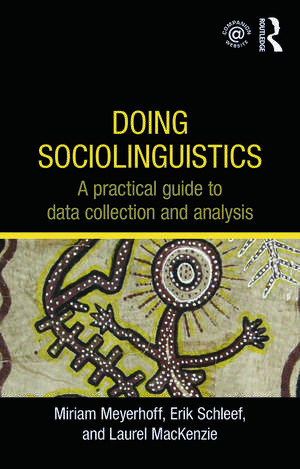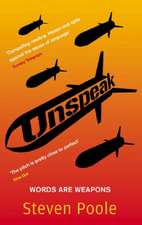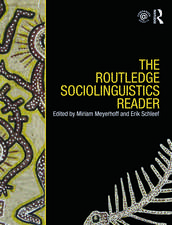Doing Sociolinguistics: A practical guide to data collection and analysis
Autor Miriam Meyerhoff, Erik Schleef, Laurel MacKenzieen Limba Engleză Paperback – 2 iul 2015
Divided into sixteen short chapters, Doing Sociolinguistics:
- can be used as a core text in class or as an easy reference whilst undertaking research
- walks readers through the different phases of a sociolinguistic project, providing all the knowledge and skills students will need to conduct their own analyses of language
- features excerpts from key research articles; exercises with real data from the authors’ own research; sample answers to the exercises; and further reading
- is supported by the Routledge Sociolinguistics Companion website (www.routledge.com/textbooks/meyerhoff) which features further online exercises with sound files.
| Toate formatele și edițiile | Preț | Express |
|---|---|---|
| Paperback (1) | 320.58 lei 6-8 săpt. | |
| Taylor & Francis – 2 iul 2015 | 320.58 lei 6-8 săpt. | |
| Hardback (1) | 698.74 lei 6-8 săpt. | |
| Taylor & Francis – 25 iun 2015 | 698.74 lei 6-8 săpt. |
Preț: 320.58 lei
Nou
Puncte Express: 481
Preț estimativ în valută:
61.34€ • 64.05$ • 50.65£
61.34€ • 64.05$ • 50.65£
Carte tipărită la comandă
Livrare economică 15-29 aprilie
Preluare comenzi: 021 569.72.76
Specificații
ISBN-13: 9780415698207
ISBN-10: 0415698200
Pagini: 212
Ilustrații: 10 black & white tables, 2 black & white halftones, 29 black & white line drawings
Dimensiuni: 138 x 216 x 13 mm
Greutate: 0.39 kg
Ediția:1
Editura: Taylor & Francis
Colecția Routledge
Locul publicării:Oxford, United Kingdom
ISBN-10: 0415698200
Pagini: 212
Ilustrații: 10 black & white tables, 2 black & white halftones, 29 black & white line drawings
Dimensiuni: 138 x 216 x 13 mm
Greutate: 0.39 kg
Ediția:1
Editura: Taylor & Francis
Colecția Routledge
Locul publicării:Oxford, United Kingdom
Public țintă
Postgraduate and UndergraduateCuprins
Preface and User Guide
PART ONE – DATA COLLECTION
1. Finding a topic
2. Sample design and the envelope of variation
3. Ethics and archiving
4. Sampling techniques and gaining access to speakers
5. Interviews as a source of data
6. Naturally-occurring, spontaneous speech as a source of data
7. Corpora as a source of data
8. Written surveys and questionnaires as a source of data
9. Studying perceptions and attitudes
PART TWO – DATA ANALYSIS
10. Transcription
11. Identifying, coding & summarising your data
12. Analysing your data
13. Presenting your data
14. Analysing multiple independent variables
15. Mixing qualitative and quantitative analysis
16. Writing up your research
PART ONE – DATA COLLECTION
1. Finding a topic
2. Sample design and the envelope of variation
3. Ethics and archiving
4. Sampling techniques and gaining access to speakers
5. Interviews as a source of data
6. Naturally-occurring, spontaneous speech as a source of data
7. Corpora as a source of data
8. Written surveys and questionnaires as a source of data
9. Studying perceptions and attitudes
PART TWO – DATA ANALYSIS
10. Transcription
11. Identifying, coding & summarising your data
12. Analysing your data
13. Presenting your data
14. Analysing multiple independent variables
15. Mixing qualitative and quantitative analysis
16. Writing up your research
Recenzii
"A highly practical and readable "how to" guide written by expert researchers, filled to the brim with helpful tips … valuable both as a textbook and as a field handbook."
James N. Stanford, Dartmouth College, USA
"These highly experienced researchers walk the budding sociolinguist through the essential stages in data collection and analysis in a no-nonsense yet highly engaging manner."
Jennifer Smith, Glasgow University, UK
"It's hard to think of another book that takes the reader so quickly and effortlessly into the heart of the field of sociolinguistic research."
Nick Evans, Australian National University
"Doing Sociolinguistics is a highly practical and readable "how to" guide written by expert researchers who know what they are doing when they do sociolinguistics. The book is filled to the brim with helpful tips and exactly the right kinds of information needed for successful data collection and analysis in the quantitative or variationist paradigm. The authors have carefully organized their advice into easy-to-follow sections with clear examples, step-by-step guidelines, case studies, exercises, practical statistics, and helpful suggestions for further reading, making the book valuable both as a textbook and as a field handbook."
James N. Stanford, Dartmouth College, USA
"Doing Sociolinguistics is a perfectly pitched title for a perfectly planned book by three perfectly placed sociolinguists. These highly experienced researchers walk the budding sociolinguistic through the essential stages in data collection and analysis in a no-nonsense yet highly engaging manner, pinpointing the key questions along the way: how much data do I need? why would I want to use a corpus? what should a graph do? In doing so, the book manages to provide a fully comprehensive ‘how to’ guide but yet in a highly accessible, ‘clear and casual' way. A most welcome addition to methods in sociolinguistic research."
Jennifer Smith, Glasgow University, UK
"This genially written and deceptively chatty guide leads the reader through the whole trajectory of sociolinguistic research, from conceiving the questions through data gathering, and on through statistical analysis and graphic presentation of results to sound design on writing up a research article. It's hard to think of another book that takes the reader so quickly and effortlessly into the heart of the field."
Nick Evans, Australian National University
James N. Stanford, Dartmouth College, USA
"These highly experienced researchers walk the budding sociolinguist through the essential stages in data collection and analysis in a no-nonsense yet highly engaging manner."
Jennifer Smith, Glasgow University, UK
"It's hard to think of another book that takes the reader so quickly and effortlessly into the heart of the field of sociolinguistic research."
Nick Evans, Australian National University
"Doing Sociolinguistics is a highly practical and readable "how to" guide written by expert researchers who know what they are doing when they do sociolinguistics. The book is filled to the brim with helpful tips and exactly the right kinds of information needed for successful data collection and analysis in the quantitative or variationist paradigm. The authors have carefully organized their advice into easy-to-follow sections with clear examples, step-by-step guidelines, case studies, exercises, practical statistics, and helpful suggestions for further reading, making the book valuable both as a textbook and as a field handbook."
James N. Stanford, Dartmouth College, USA
"Doing Sociolinguistics is a perfectly pitched title for a perfectly planned book by three perfectly placed sociolinguists. These highly experienced researchers walk the budding sociolinguistic through the essential stages in data collection and analysis in a no-nonsense yet highly engaging manner, pinpointing the key questions along the way: how much data do I need? why would I want to use a corpus? what should a graph do? In doing so, the book manages to provide a fully comprehensive ‘how to’ guide but yet in a highly accessible, ‘clear and casual' way. A most welcome addition to methods in sociolinguistic research."
Jennifer Smith, Glasgow University, UK
"This genially written and deceptively chatty guide leads the reader through the whole trajectory of sociolinguistic research, from conceiving the questions through data gathering, and on through statistical analysis and graphic presentation of results to sound design on writing up a research article. It's hard to think of another book that takes the reader so quickly and effortlessly into the heart of the field."
Nick Evans, Australian National University
Descriere
Doing Sociolinguistics: A practical guide to data collection and analysis is an accessible introduction and guide to the methods of data collection and analysis in the field of sociolinguistics. It provides students with all the knowledge and skills needed to conduct their own analyses of language, featuring excerpts from key research articles, exercises using real data from the authors’ own research, and supported by a companion website. Designed to function both as a core text for methods classes in sociolinguistics, and as a companion to the Routledge textbook Introducing Sociolinguistics, this book will be essential reading for all students studying and researching in this area.
















